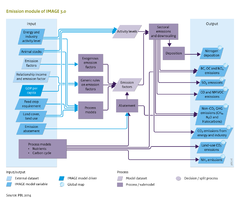Emissions/Description: Difference between revisions
Jump to navigation
Jump to search
No edit summary |
No edit summary |
||
| Line 13: | Line 13: | ||
:The equation for this emission factor approach is: | :The equation for this emission factor approach is: | ||
::Emission = Activity<sub>r,i</sub> * EF-base<sub>r,i</sub> * AF <sub>r,i</sub> | ::Emission = Activity<sub>r,i</sub> * EF-base<sub>r,i</sub> * AF <sub>r,i</sub> (Equation 1) | ||
:where: | :where: | ||
:* Emission is the emission of the specific gas or aerosol; | :* Emission is the emission of the specific gas or aerosol; | ||
| Line 30: | Line 30: | ||
4) ''Gridded process model (GPM)'' | 4) ''Gridded process model (GPM)'' | ||
:Land-use related emissions of NH3, N2O and NO are calculated with grid-specific models (Figure | :Land-use related emissions of NH3, N2O and NO are calculated with grid-specific models (Figure Flowchart). The models included in IMAGE are simple regression models that generate an emission factor (Figure Flowchart). For comparison with other models, IMAGE also includes the N2O methodology generally proposed by {{abbrTemplate|IPCC}} ([[IPCC, 2006]]). | ||
The approaches used to calculate emissions from energy production and use, industrial processes and land-use related sources are discussed in more detail below. | The approaches used to calculate emissions from energy production and use, industrial processes and land-use related sources are discussed in more detail below. | ||
===Emissions from energy production and use=== | ===Emissions from energy production and use=== | ||
Emission factors (Equation | Emission factors (Equation 1) are used for estimating emissions from the energy-related sources (Table 5.2.2). In general, the Tier 1 approach from IPCC guidelines (IPCC, 2006) is used. In the energy system, emissions are calculated by multiplying energy use fluxes by time-dependent emission factors. Changes in emission factors represent, for example, technology improvements and end-of-pipe control techniques, fuel emission standards for transport, and clean-coal technologies in industry. | ||
The emission factors for the historical period for the energy system and industrial processes are calibrated with the EDGAR emission model described by Braspenning Radu et al. (2012). Calibration to the EDGAR database is not always straightforward because of differences in aggregation level. The general rule is to use weighted average emission factors for aggregation. However, where this results in incomprehensible emission factors (in particular, large differences between the emission factors for the underlying technologies), specific emission factors were chosen. | The emission factors for the historical period for the energy system and industrial processes are calibrated with the EDGAR emission model described by Braspenning Radu et al. (2012). Calibration to the EDGAR database is not always straightforward because of differences in aggregation level. The general rule is to use weighted average emission factors for aggregation. However, where this results in incomprehensible emission factors (in particular, large differences between the emission factors for the underlying technologies), specific emission factors were chosen. | ||
Future emission factors are based on the following rules: | Future emission factors are based on the following rules: | ||
Revision as of 09:02, 21 May 2014
Parts of Emissions/Description
| Component is implemented in: |
Components:and
|
| Projects/Applications |
| Models/Databases |
| Key publications |
| References |
|
